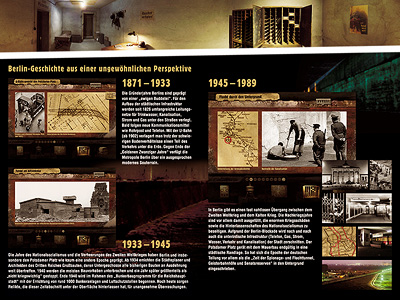
The years following 1871, when Berlin becomes the capital of Germany, are characterized by “constant digging”. In order to develop the urban infrastructure, extensive subterranean networks supplying the city with water, electricity and gas have already been built since 1826. This also applies to the sewage system. Modern communication techniques like the pneumatic dispatch system and the telephone follow soon. With the arrival of the metro in 1902, at least some of the traffic can be diverted underground - despite the hazardous conditions facing the engineers down there. By the end of the “Roaring Twenties”, the city boasts a very modern underground.
The Nazi era and the devastation resulting from the World War Two have shaped Berlin, and especially the Potsdamer Platz, like no other period. Since 1934, the town planners and architects of the Third Reich erect huge buildings with vast, unprecedented subterranean structures. Most of these programs, however, are stopped in 1940 and finally laid to rest a year later - they are “not crucial to the war effort”. By the end of 1940, the “Bunker Building Program for the Capital of the Reich” is initiated and work starts on over a thousand air raid bunkers and tunnels. Nowadays, the relics of that era still harbour some unpleasant surprises.
In Berlin, World War Two is almost immediately followed by the cold war. The postwar years are characterized by the attempt to rebuild the devastated city and clear away the remains of Nazism. The blockade of West Berlin by the Soviets, however, severs the city’s subterranean infrastructure (phone lines, gas, electricity, water, traffic and the sewage system). When the Berlin Wall is built in 1961, the Potsdamer Platz suddenly finds itself at the periphery of the city. The following decades stamp their mark into Berlin’s underground as the “Era of Spy Tunnels and Escape Tunnels, Ghost Stations and Senate Reserves”.























